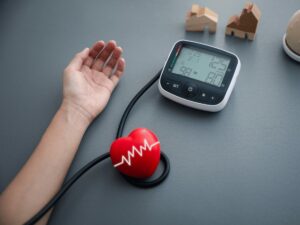Does hyperbaric oxygen therapy affect blood pressure? Research shows it can have variable effects, depending on individual health conditions and therapy protocols.
With years of expertise in hyperbaric therapy, our insights draw from the latest scientific findings and clinical practices.
In this article, we will explore the mechanisms behind hyperbaric oxygen therapy’s impact on blood pressure. We aim to demystify common misconceptions and highlight critical safety considerations.
Read on to discover crucial insights within!
1. The Science Behind HBOT and Blood Pressure
Hyperbaric oxygen therapy involves breathing pure oxygen in a pressurized chamber. This process significantly increases the amount of oxygen the blood can carry, an enhancement with profound effects on the body, including the cardiovascular system. Now, this is important, because added oxygen has the potential to improve circulation and stimulate the healing of damaged tissues, factors that can directly or indirectly influence blood pressure.
According to a study referenced on PubMed, absolute increases in blood pressure do occur as a result of Hyperbaric Oxygen Therapy. However, the magnitude of this effect is not substantial.
For those interested in integrating the advantages of HBOT into their healthcare offerings, Oxygen-ark provides hyperbaric chambers designed to meet the diverse needs of patients.

2. Positive Effects of HBOT on Blood Pressure and Circulation
After looking into how HBOT can slightly affect blood pressure, it’s clear that this treatment offers more than meets the eye. Here’s the interesting part; while we’ve discussed how HBOT can lead to subtle changes in blood pressure, the flip side reveals positive effects. Here are the significant benefits that warrant attention:
Enhanced Oxygen Delivery
HBOT increases the oxygen carrying capacity of the blood, facilitating improved oxygen delivery to tissues and organs. This can lead to the normalization of blood pressure levels in patients with varying conditions. For example, individuals with peripheral artery disease may experience improved circulation and reduced symptoms.
Reduced Inflammation
The therapy has been shown to decrease inflammation, a common culprit behind vascular constriction and elevated blood pressure. By reducing inflammation, HBOT can help maintain healthier blood flow and pressure levels.
Promotion of Angiogenesis
But wait, there’s more; HBOT can stimulate the growth of new blood vessels in areas with reduced circulation. This angiogenesis is crucial for healing and restoring normal blood flow, which can indirectly stabilize blood pressure by improving overall vascular health.
Improved Vascular Reactivity
HBOT enhances the ability of blood vessels to dilate and constrict appropriately, improving the body’s ability to regulate blood pressure in response to various stimuli.
Mitigation of Hypoxia-Induced Constriction
Finally, HBOT can counteract the body’s natural response to lower oxygen levels, which is to increase blood pressure to accelerate oxygen delivery. By providing an ample oxygen supply, HBOT reduces the need for this compensatory mechanism, leading to more stable blood pressure readings.

3. Potential Side Effects of HBOT in Relation to Blood Pressure
While hyperbaric oxygen therapy (HBOT) boasts numerous benefits, it’s essential to be aware of potential side effects concerning blood pressure. Here’s why that’s important; understanding these can help manage expectations and ensure patient safety during treatment. Here are the potential side effects to note:
Temporary Blood Pressure Increases
Some patients may experience a temporary rise in blood pressure during their HBOT sessions. This increase is typically mild and resolves shortly after the session ends.
Variations in Blood Pressure Post-Treatment
After completing HBOT, some individuals may notice fluctuations in their blood pressure levels. These variations are generally short-lived and tend to stabilize with time. It’s important for patients to monitor their blood pressure and report any significant changes to their healthcare provider.
Hypotension in Some Cases
Following a session, there’s a possibility of blood pressure dropping below usual levels for some patients. Although less common, this hypotensive effect warrants careful observation after treatment, ensuring patient safety.
Interactions with Blood Pressure Medications
Patients taking medication to manage high blood pressure may experience interactions with HBOT. The therapy can alter the effectiveness of blood pressure medications, necessitating adjustments in dosage or treatment plans under the guidance of a healthcare professional.
4. HBOT vs. Traditional Blood Pressure Treatments
Hyperbaric oxygen therapy (HBOT) and traditional blood pressure treatments serve different primary purposes, yet both can influence blood pressure. So what’s my point? Understanding these differences is crucial for integrating HBOT into patient care effectively. Here are the key distinctions:
Approach to Treatment
Traditional treatments for blood pressure often involve medications designed to lower pressure by relaxing blood vessels, reducing blood volume, or decreasing heart rate. HBOT, on the other hand, doesn’t target blood pressure directly but can affect it through improved oxygenation and reduced inflammation.
For instance, someone using beta-blockers experiences direct effects on their heart rate and blood pressure, unlike the indirect benefits of HBOT.
Underlying Mechanisms
HBOT increases the amount of oxygen in the blood, promoting healing and potentially improving circulation. This can have a stabilizing effect on blood pressure, unlike traditional medications that specifically aim to lower blood pressure through various biochemical pathways.
Long-term Impact
Traditional medications require ongoing use to manage blood pressure, with adjustments over time based on the patient’s condition and response. HBOT may offer longer-term benefits after a completed series of treatments by addressing some underlying issues contributing to high blood pressure, such as chronic inflammation or poor circulation.
| Aspect |
Traditional Medications |
Hyperbaric Oxygen Therapy (HBOT) |
| Treatment Duration |
Requires ongoing use |
Completed series of treatments |
| Mechanism of Action |
Pharmacological interventions |
Addresses underlying issues |
| Long-term Benefits |
May require adjustments over time |
Potential longer-term benefits |
| Addressed Issues |
Focuses on symptom management |
Targets underlying causes |
| Side Effects |
Potential for medication side effects |
Fewer reported side effects |
5. 5 Tips for Individuals with Hypertension Considering HBOT
Do you ever wonder if hyperbaric oxygen therapy (HBOT) is a safe option for someone with hypertension? Navigating treatment options can seem daunting, especially when trying to balance health benefits against potential risks. Here are 5 key tips to guide individuals with high blood pressure considering HBOT:
#1 Blood Pressure Below 140/90 mmHg Before Session
Before starting HBOT, patients should undergo a comprehensive blood pressure evaluation, including 24-hour ambulatory monitoring. The aim is for systolic blood pressure to consistently stay below 140 mmHg and diastolic pressure below 90 mmHg under various conditions, establishing a safe baseline for therapy.
#2 Adjust Medication Timing 1-2 Hours Before HBOT
Patients need to coordinate with their healthcare providers to adjust the timing of blood pressure medications to optimize therapy outcomes. If an HBOT session is scheduled for the morning, taking antihypertensive medication early enough to allow peak effect during treatment can help manage potential increases in blood pressure. This may involve adjusting medication timing to 1-2 hours before the HBOT session.
#3 1.5 ATA Pressure Setting
Initiating hyperbaric oxygen therapy (HBOT) at a pressure setting of 1.5 ATA serves as a strategic approach to enhance patient comfort and minimize potential adverse effects associated with blood pressure fluctuations. This practice is particularly beneficial for patients diagnosed with hypertension. Starting at a lower ATA level allows for a gradual adjustment, thus ensuring a safer adaptation to the hyperbaric environment.
If you’re looking for hyperbaric chambers that offer various pressure settings to suit a wide range of medical needs, explore Oxygen-ark’s solutions. Our chambers are designed with patient safety and comfort in mind.
#4 Keep Blood Pressure Below 150/100 mmHg After Session
A strict regimen for monitoring blood pressure immediately after each HBOT session and several hours later should be implemented. Any spike in blood pressure post-HBOT to levels above 150/100 mmHg would necessitate immediate consultation with a healthcare provider to evaluate the need for therapeutic adjustment or medication intervention.
#5 Emergency Plan
It is essential that the HBOT facility has an emergency protocol for significant blood pressure elevations, including the on-site availability of fast-acting antihypertensive sublingual medications, such as nifedipine, which can quickly lower blood pressure in emergencies.
Dive Deeper Into Our Resources
Looking for more diverse product options? Browse through our handpicked selections:
Still haven’t found what you’re looking for? Don’t hesitate to contact us. We’re available around the clock to assist you.
Conclusion
Exploring whether hyperbaric oxygen therapy impacts blood pressure reveals its complex yet beneficial relationship with our cardiovascular health. This guide has shed light on how HBOT can be safely integrated into treatment plans, particularly for those monitoring their blood pressure.
For businesses interested in learning more about hyperbaric chambers and their impact on blood pressure, Oxygen-ark offers in-depth expertise and solutions. Feel free to contact us to explore how we can assist your needs.


